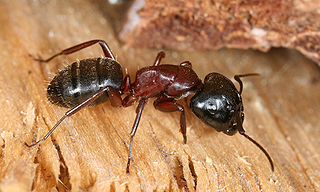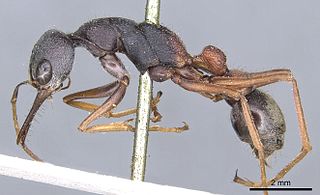
Lasius is a genus of formicine ants. The type species for this genus is the black garden ant, Lasius niger. Other major members, which live in drier heathland, are the cornfield ant, L. neoniger, and L. alienus. Other species include the temporary social parasites of the L. mixtus group and the hyper-social parasite Lasius fuliginosus. Lasius flavus is also a commonly seen species, building grassy hillocks in undisturbed pasture. In the Alps, these mounds – always aligned east to catch the first rays of the rising sun – have been traditionally used by goatherds as natural compasses. Species in the subgenus Acanthomyops, in particular L. interjectus and L. claviger, are commonly known as citronella ants due to their citronella-like smell.

The Formicinae are a subfamily within the Formicidae containing ants of moderate evolutionary development.

Myrmecia is a genus of ants first established by Danish zoologist Johan Christian Fabricius in 1804. The genus is a member of the subfamily Myrmeciinae of the family Formicidae. Myrmecia is a large genus of ants, comprising at least 93 species that are found throughout Australia and its coastal islands, while a single species is only known from New Caledonia. One species has been introduced out of its natural distribution and was found in New Zealand in 1940, but the ant was last seen in 1981. These ants are commonly known as bull ants, bulldog ants or jack jumper ants, and are also associated with many other common names. They are characterized by their extreme aggressiveness, ferocity, and painful stings. Some species are known for the jumping behavior they exhibit when agitated.

Carpenter ants are large ants indigenous to many forested parts of the world.

Dolichoderinae is a subfamily of ants, which includes species such as the Argentine ant, the erratic ant, the odorous house ant, and the cone ant. The subfamily presents a great diversity of species throughout the world, distributed in different biogeographic realms, from the Palearctic, Nearctic, Afrotropical region and Malaysia, to the Middle East, Australian, and Neotropical regions.

Cephalotes is a genus of tree-dwelling ant species from the Americas, commonly known as turtle ants. All appear to be gliding ants, with the ability to "parachute" and steer their fall so as to land back on the tree trunk rather than fall to the ground, which is often flooded.

Leptomyrmex, or spider ants, is a genus of ants and a distinctive member of the ant subfamily Dolichoderinae. Commonly known as "spider ants" for their long legs and spider-like movements, these orange and black ants are prominent residents of intact wet forest and sclerophyll habitats throughout their range. One extant species, Leptomyrmex relictus, is known from central Brazil; otherwise, the global distribution of this genus is restricted to eastern Australia, New Caledonia and New Guinea, as well as the nearby Indonesian islands of Aru and Seram.

Crematogaster is an ecologically diverse genus of ants found worldwide, which are characterised by a distinctive heart-shaped gaster (abdomen), which gives them one of their common names, the Saint Valentine ant. Members of this genus are also known as cocktail ants because of their habit of raising their abdomens when alarmed. Most species are arboreal (tree-dwelling). These ants are sometimes known as acrobat ants.

Camponotini is a tribe containing 2 extinct ant genera and 8 extant ant genera, including Camponotus.

Rhytidoponera is a large genus of ants in the subfamily Ectatomminae. The genus is known from Australia and Melanesia, with New Caledonia as the most eastern limit.

Dolichoderus is a genus of ants found worldwide.

Nylanderia is a large genus of ants in the subfamily Formicinae. The genus has a nearly cosmopolitan distribution with species inhabiting a wide array of habitats in almost all geographic regions. Nylanderia, currently containing over 110 species, is an ecologically important genus, with some species reported as being invasive. The ants are small to medium in size and range in color from pale yellow to black.

Myrmecia piliventris, the golden tail bull ant, is an Australian ant which belongs to the genus Myrmecia. This species is native to Australia. The Myrmecia piliventris is distributed Australia wide, but they're not too common in the western regions of Australia.
Myrmecia ferruginea is an Australian ant which belongs to the genus Myrmecia. This species is native to Australia. The Myrmecia ferrguinea has been notably distributed in Queensland.

Myrmecia varians is an Australian ant which belongs to the genus Myrmecia. This species is endemic to Australia. The Myrmecia varians is one of the most distributed ants in the country, with the species being observed in every single state and territory except for Tasmania. Myrmecia varians was first described by Mayr in 1876.
Kempfidris is a Neotropical genus of ants in the subfamily Myrmicinae containing the single species Kempfidris inusualis. Known from Brazil, Ecuador and Venezuela, the species was originally described as Monomorium inusuale in 2007, but was reclassified as the type species for the new genus Kempfidris in 2014. The species is only known from workers and almost nothing is known about their natural history.

Ectomomyrmex is a ponerine genus of ants found in Asia and Australia. Little is known about their biology, but they seem to be generalist predators of arthropod prey.

Colobopsis is a genus of ants in the subfamily Formicinae. This genus was first described in 1861 by Mayr and contains 95 species. The type species is Colobopsis truncata.
Tetraponera penzigi is a species of ant of the subfamily Pseudomyrmecinae, which can be found in East Africa. It forms an obligate symbiosis with the whistling thorn acacia, a dominant tree in some upland areas of East Africa.
















